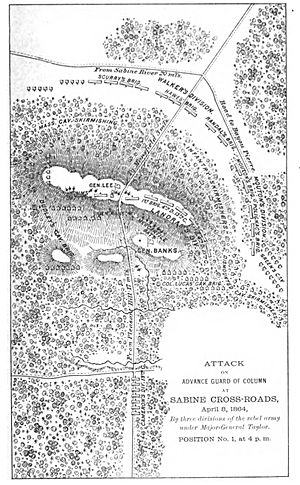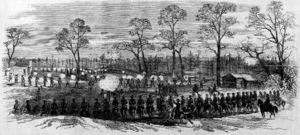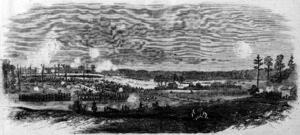Battle of Mansfield facts for kids
Quick facts for kids Battle of Mansfield |
|||||||
|---|---|---|---|---|---|---|---|
| Part of the Trans-Mississippi Theater of the American Civil War |
|||||||
 Map of the battlefield, 1891 |
|||||||
|
|||||||
| Belligerents | |||||||
| Commanders and leaders | |||||||
| Units involved | |||||||
| District of West Louisiana | Army of the Gulf | ||||||
| Strength | |||||||
| 8,800 to 9,000 engaged | 20,000 12,000 engaged |
||||||
| Casualties and losses | |||||||
| 1,000 total | 2,235 total 113 killed 581 wounded 1,541 captured/missing |
||||||
The Battle of Mansfield, also known as the Battle of Sabine Crossroads, happened on April 8, 1864. It was a major fight in Louisiana during the American Civil War. This battle was part of the Red River Campaign. Union forces were trying to take over Shreveport, which was an important city in Louisiana.
The Confederate commander, Major-General Dick Taylor, decided to make his stand at Mansfield. He gathered his soldiers there to stop the Union army. The Union army was led by General Nathaniel Banks. Both sides received more soldiers as the day went on. After a tough fight, the Union army was defeated by the Confederates. Most of the Confederate soldiers were from Louisiana and Texas.
The Battle of Mansfield was quickly followed by another battle. This next fight was called the Battle of Pleasant Hill.
Contents
Why the Battle Happened: The Red River Campaign
The Battle of Mansfield was part of a bigger plan called the Red River Campaign. In March 1864, a large Union force started moving up the Red River. This force included soldiers from the Army of the Gulf and ships from the navy. Their main goal was to defeat the Confederate forces in Louisiana. They also wanted to capture Shreveport, a key city.
Union Advance Up the Red River
By April 1, Union soldiers had taken control of Grand Ecore and Natchitoches. While some ships and soldiers continued up the river, the main Union army marched inland. They followed the road towards Mansfield. General Banks knew that the Confederate army was gathering there.
Confederate Preparation for a Stand
Major General Richard Taylor was in charge of the Confederate forces in Louisiana. He had been moving his troops back up the Red River. He wanted to meet up with more soldiers coming from Texas and Arkansas. Taylor chose a clear area a few miles south of Mansfield as the place to fight. He sent his cavalry (soldiers on horseback) to bother the Union army as it got closer. Then, he called his main infantry (foot soldiers) divisions forward.
The Race to the Battlefield
On the morning of April 8, General Banks's army was spread out. They were marching along a single road through the woods. This road connected Natchitoches and Mansfield. The Union cavalry at the front found the Confederates in a strong position. They were at the edge of a clearing. The cavalry stopped and asked for infantry support.
General Banks rode to the front and decided to fight Taylor right there. He ordered all his foot soldiers to hurry up the road. It became a race. Both sides tried to bring their soldiers to the front lines as fast as possible.
Who Fought: The Armies
Both the Confederate and Union armies had many soldiers ready to fight. They also had more troops arriving during the battle.
Confederate Forces
At the start of the battle, General Taylor had about 9,000 soldiers. These included:
- Brigadier General Alfred Mouton's infantry division (from Louisiana and Texas).
- Major General John G. Walker's Texas infantry division, known as Walker's Greyhounds.
- Brigadier General Thomas Green's Texas cavalry division.
- Colonel William Vincent's Louisiana cavalry brigade.
Taylor had also called for 5,000 more soldiers. These were from the divisions of Brigadier General Thomas J. Churchill and Brigadier General Mosby M. Parsons. They were camped near Keachi, between Mansfield and Shreveport. These extra troops arrived late in the afternoon, after the battle had already started.
There were also reports of more Louisiana men joining the fight. Some were soldiers who had been released after surrendering at Vicksburg. The Confederate Governor of Louisiana, Henry Watkins Allen, even brought two groups of state guard soldiers to help Taylor. Some accounts say that "old men shouldered their muskets" from nearby towns to help.
Union Forces
When the battle began, the Union forces included:
- A cavalry division led by Brigadier General Albert L. Lee, with about 3,500 men.
- The 4th Division of the XIII Corps, led by Colonel William J. Landram, with about 2,500 men.
During the battle, more Union soldiers arrived. The 3rd Division of the XIII Corps, led by General Robert A. Cameron, came with about 1,500 men. The battle ended when the chasing Confederates met the 1st Division of the XIX Corps. This division was led by Brigadier General William H. Emory and had about 5,000 men. This included the 47th Pennsylvania Infantry Regiment, which was the only regiment from Pennsylvania in the 1864 Red River Campaign. General Thomas E. G. Ransom was in charge of the XIII Corps during the fight. General William B. Franklin commanded the XIX Corps.
The Battle Unfolds
In the morning, General Taylor placed Mouton's division on the east side of the clearing. Walker's division arrived in the afternoon and lined up next to Mouton's on the right. As Green's cavalry fell back from the Union advance, some moved to protect Mouton's side, and others moved to Walker's side. The Arkansas division arrived around 3:30 pm but was sent to watch a road to the east. The Missouri division did not arrive until around 6:00 pm, after the main fighting was over.
Around noon, the Union cavalry division, supported by one infantry group, took a position on a small hill. This hill was at the south end of the clearing. Soon after, another infantry group arrived. Cameron's division was on its way but would not get there before the battle started.
For about two hours, the two armies faced each other across the clearing. General Banks waited for more of his soldiers to arrive. General Taylor arranged his men. At this point, Taylor had more soldiers than Banks.
Confederate Attack and Union Retreat
Around 4:00 pm, the Confederates charged forward. On the east side of the road, General Mouton was killed. Several of his regimental commanders were also hit. His division's attack was pushed back. However, west of the road, Walker's Texas division moved around the Union position. They surrounded the Union soldiers, trapping them.
General Ransom was wounded while trying to gather his men. He had to be carried off the field. Hundreds of Union soldiers were captured, and the rest ran away in a panic. As the first Union line broke, Cameron's division arrived to form a second line. But they too were pushed back by the charging Confederates. General Franklin was also wounded but stayed on the field to command.
The Confederates chased the retreating Union troops for several miles. They finally met a third line formed by Emory's division. The Confederates tried to attack this Union line several times but were stopped. Nightfall then ended the battle.
What Happened Next
The Union forces suffered heavy losses. They had 113 soldiers killed, 581 wounded, and 1,541 captured. They also lost 20 cannons, 156 wagons, and a thousand horses and mules. More than half of the Union losses came from just four regiments. Most of the Union casualties were from the XIII Corps. The XIX Corps lost very few men.
The Confederate losses were reported as "about 1,000 killed and wounded" at Mansfield. However, exact details of Confederate losses were not fully recorded. Some wounded soldiers were taken to Minden for treatment. Those who died there were buried without markers in the historic Minden Cemetery. Markers were finally placed for them on March 25, 2008. The town of Keachi turned its women's college into a hospital and morgue. One hundred soldiers are buried in Keachi's Confederate Cemetery nearby. This cemetery is cared for by local groups.
After the Union troops retreated, they fought the Confederates again the next day. This battle happened on April 9 at the Battle of Pleasant Hill.
Protecting the Battlefield
Efforts are being made to preserve the land where the Battle of Mansfield took place. On April 7, 2017, the American Battlefield Trust announced a partnership with Cleco, an energy company. Together, they preserved 14.5 acres of the Mansfield Battlefield. This was the first part of the battle's final phase to be saved. Including this land, the Trust and its partners have now protected 435 acres of the battlefield.
Images for kids







